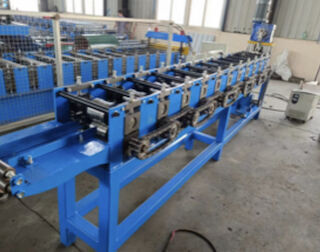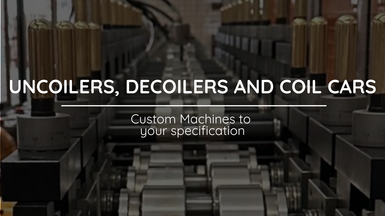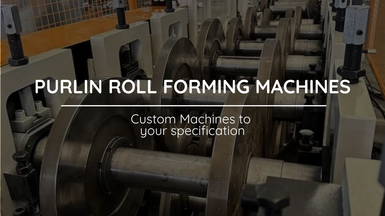
Metal Hat Channel Roll Forming Machine
Here's how a typical metal hat channel roll forming machine works:
Posted on Monday, November 20, 2023
A metal hat channel roll forming machine is a specialized piece of equipment used in the manufacturing and construction industries to produce hat-shaped metal channels or profiles from sheet metal coils. These hat channels are often used as structural components in building construction, particularly for framing walls and ceilings, as well as in various other applications where strength and support are required.
Here's how a typical metal hat channel roll forming machine works:
- Material Feeding: The process begins by feeding a coil of sheet metal into the machine. The sheet metal coil can be made of various materials, such as steel, aluminum, or galvanized steel, depending on the application and the desired properties of the hat channels.
- Roll Forming: The machine uses a series of specially designed rollers and dies to gradually shape the flat sheet metal into the desired hat channel profile. The rollers are strategically positioned along the length of the machine, and each set of rollers performs a specific bending or forming operation. This gradual forming process ensures precision and consistency in the shape and dimensions of the hat channels.
- Cutting: After the metal has been formed into the hat channel profile, a cutting mechanism is used to cut the channels to the desired length. The cutting process can be either a shearing action or a sawing action, depending on the machine's design.
- Stacking or Packaging: Once the hat channels are cut to the appropriate lengths, they can be stacked, bundled, or packaged for easy handling, storage, and transportation.
These machines are typically computer-controlled and can be adjusted to produce hat channels with different dimensions and profiles by changing the settings and tooling. This versatility makes them suitable for various applications in the construction industry.
Hat channels are commonly used to create a framework for attaching drywall, insulation, or other building materials in walls and ceilings. They provide structural support, help with soundproofing, and can serve as a conduit for electrical and plumbing installations. Additionally, hat channels are often used in the automotive and manufacturing industries for various structural and framing purposes.
Overall, a metal hat channel roll forming machine is an essential tool for efficiently and precisely producing hat channels from sheet metal coils, making it a valuable asset in metal fabrication and construction processes.
Metal Hat Channel Profile
A metal hat channel profile, often referred to simply as a "hat channel," is a type of metal profile or shape that resembles the shape of a hat, hence its name. Hat channels are commonly used in construction and various industrial applications for their strength, rigidity, and versatility. They are typically made from materials like steel, aluminum, or galvanized steel and come in various sizes and configurations to suit different purposes.
The basic design of a metal hat channel profile consists of a flat top or "brim" section and two perpendicular sides, which can be referred to as the "legs" or "flanges." The profile's cross-sectional shape resembles the letter "U" or a hat, with the open side of the U facing downwards. The dimensions and thickness of the metal used to create the hat channel can vary depending on the specific application and the load-bearing requirements.
Here are some common uses and characteristics of metal hat channel profiles:
- Structural Support: Hat channels are often used as structural components in building construction. They are attached to walls and ceilings to provide support for attaching materials such as drywall, sheetrock, or ceiling tiles. This helps create a sturdy and even surface for finishing work.
- Soundproofing: In addition to providing structural support, hat channels can help with soundproofing by creating an air gap between the framing and the wall or ceiling surface. This air gap can reduce the transmission of sound and improve acoustics.
- Conduit for Services: Hat channels can be used as a concealed conduit for running electrical wiring, plumbing, or HVAC ductwork within walls and ceilings. This helps maintain a clean and finished appearance while allowing for easy access to services if needed.
- Load Distribution: In industrial applications, hat channels can be used to distribute loads or provide additional support for heavy equipment or machinery. They can be installed horizontally or vertically to suit the specific load-bearing requirements.
- Framing in Various Industries: Beyond construction, hat channels find use in various industries, including automotive, manufacturing, and aerospace, for framing, reinforcement, and structural purposes.
The dimensions of a metal hat channel profile, such as the width of the brim and the height of the legs, can vary depending on the desired strength and the specific application. These profiles are typically produced using roll forming machines, which can create consistent and precise shapes from sheet metal coils.
In summary, a metal hat channel profile is a versatile and widely used metal shape with a U-shaped cross-sectional design, commonly employed in construction and other industries for structural support, soundproofing, conduit for services, load distribution, and framing purposes. The specific dimensions and materials used can vary based on the intended application.
Metal Hat Channel Sizes
Metal hat channels come in various sizes, and the specific dimensions can vary depending on the manufacturer, industry standards, and the intended application. The size of a metal hat channel is typically defined by its width, height, and thickness. Here are some common metal hat channel sizes:
- Width:
- Common widths for metal hat channels range from 1 inch (25.4 mm) to 3 inches (76.2 mm) or more.
- Wider hat channels are often used for heavy-duty applications or when a larger surface area is needed for attaching materials.
- Height:
- The height of a hat channel's legs or flanges can vary widely. Common heights include 1 inch (25.4 mm), 1.5 inches (38.1 mm), 2 inches (50.8 mm), and 2.5 inches (63.5 mm), among others.
- Taller hat channels are typically used when higher load-bearing capacity or greater clearance is required.
- Thickness:
- The thickness of a metal hat channel's material can also vary, typically ranging from 16 gauge (0.0598 inches or 1.52 mm) to 12 gauge (0.1046 inches or 2.66 mm).
- Thicker materials provide increased strength and rigidity.
It's important to note that manufacturers may offer custom sizes and thicknesses based on specific project requirements. Additionally, industry standards and local building codes may dictate the minimum size and thickness of hat channels in certain construction applications.
The choice of metal hat channel size should be based on factors such as the structural requirements of the project, the weight and type of materials being attached to it, and the intended use. Engineers and architects often specify the appropriate size and spacing of hat channels in construction projects to ensure structural integrity and compliance with building codes.
When selecting a metal hat channel size, it's essential to consider the load-bearing capacity, deflection limits, and acoustic or insulation requirements for the specific application. Consulting with a structural engineer or design professional can help ensure that the chosen sizes meet the project's needs.
All our machines are all due to variations in the customer's demand, and we are always ready to assist with any issues. All machines are assembled by our expert team in Orlando, Florida. We have been leading the Roll Forming Machine market since 2009, and have great expertise, so you will be in safe hands. For further information, contact our team here.
For more Machines, browse our extensive range here
Roll Forming Machines LLC's New Factory
Posted on Sunday, March 23, 2025
We have relocated factories, which will be available for tours very soon.

Uncoiler, Decoiler and Coil Car Roll Forming Machine Accesories from Roll Forming Machines LLC
Posted on Sunday, November 24, 2024
Contact us today with your specifications for a custom Uncoiler, Decoiler or Coil Car at [email protected] or call us at (+1) (407) 859 1119

Stud and Track Roll Forming Machines from Roll Forming Machines LLC
Posted on Saturday, November 23, 2024
Contact us today with your specifications for a custom Stud and Track Machine at [email protected] or call us at (+1) (407) 859 1119

Cee and Zee Purlin Roll Forming Machines from Roll Forming Machines LLC
Posted on Saturday, November 23, 2024
Contact us today with your specifications for a custom Cee and Zee Purlin Machine at [email protected] or call us at (+1) (407) 859 1119